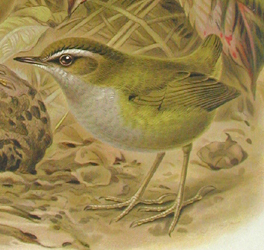- Bush Wren
Taxobox
name = Bush Wren

image_width = 220px
status = EX | status_system = IUCN3.1
extinct = 1972
regnum =Animal ia
phylum = Chordata
classis = Aves
ordo =Passeriformes
subordo =Acanthisitti
familia =Acanthisittidae
genus = "Xenicus "
species = "X. longipes"
binomial = "Xenicus longipes"
binomial_authority = (Gmelin, 1789)The Bush Wren ("Xenicus longipes"), or Mātuhituhi in Maori, was a very small and almost flightless
bird endemic toNew Zealand . It grew to about 9 cm long and 16 g in weight. It fed mostly oninvertebrate s which it captured by running along the branches of trees. It nested on or near the ground.It was widespread throughout the main islands of the country until the late 19th century when mustelids were introduced and joined
rat s as invasive mammalian predators. The only authenticated reports of theNorth Island subspecies ("X. l. stokesi") since 1900 were from the southernRimutaka Range in 1918 and the Ureweras up to 1955, with probable sightings onJune 13 ,1949 , nearLake Waikareiti , and several times in the first half of the 20th century in theHuiarau Range , and fromKapiti Island in 1911 (Edgar, 1949; St. Paul & McKenzie, 1977; Miskelly, 2003). Apparently, the last population lived in the area whereTe Urewera National Park was established, ironically just around the time of its extinction.The last authenticated reports of the
South Island subspecies ("X. l. longipes") were fromArthur's Pass in 1966 andNelson Lakes National Park in 1968. There have been a few unsubstantiated reports since then fromFiordland and Nelson Lakes.The third subspecies, "X. l. variabilis" or Stead's Bush Wren, was found on
Stewart Island/Rakiura and nearby islands. It is known to have survived on Stewart Island until 1951 (Dawson, 1951) but was probably exterminated byferal cat s. It lived on Kotiwhenua (Solomon) Island, being reasonably common, until the early 1960s. It survived on predator-freeBig South Cape Island untilBlack Rat s invaded it in 1964. The New Zealand Wildlife Service attempted to save the species by relocating all the birds they could capture. They caught six birds and transferred them toKaimohu Island where they were last seen in 1972.The species is probably extinct but it is not impossible that it survives.
References
* Dawson, E. W. (1951): Bird Notes from Stewart Island. "Notornis" 4(6): 146-150. [http://www.notornis.org.nz/free_issues/Notornis_04-1951/Notornis_4_6.pdf PDF fulltext]
* Edgar, A. T. (1949): Winter Notes on N.Z. Birds. "New Zealand Bird Notes" 3(7): 170-174. [http://www.notornis.org.nz/free_issues/Notornis_03-1949/Notornis_3_7.pdf PDF fulltext]
* Miskelly, Colin (2003): An historical record of bush wren ("Xenicus longipes") on Kapiti Island. "Notornis" 50(2): 113–114. [http://www.notornis.org.nz/free_issues/Notornis_50-2003/Notornis_50_2_113.pdf PDF fulltext]
* St. Paul, R. & McKenzie, H. R. (1977): A bushman's seventeen years of noting birds. Part F (Conclusion of series) - Notes on other native birds. "Notornis" 24(2): 65–74. [http://www.notornis.org.nz/free_issues/Notornis_24-1977/Notornis_24_2.pdf PDF fulltext]External links
* [http://nlbif.eti.uva.nl/naturalis/detail?lang=uk&id=1 3D view] of specimen RMNH 110.000 at
Naturalis , Leiden (requiresQuickTime browser plugin).
* [http://www.teara.govt.nz/TheBush/Conservation/Extinctions/6/ENZ-Resources/Standard/1/en#breadcrumbtop Bush Wren photography.]
Wikimedia Foundation. 2010.
